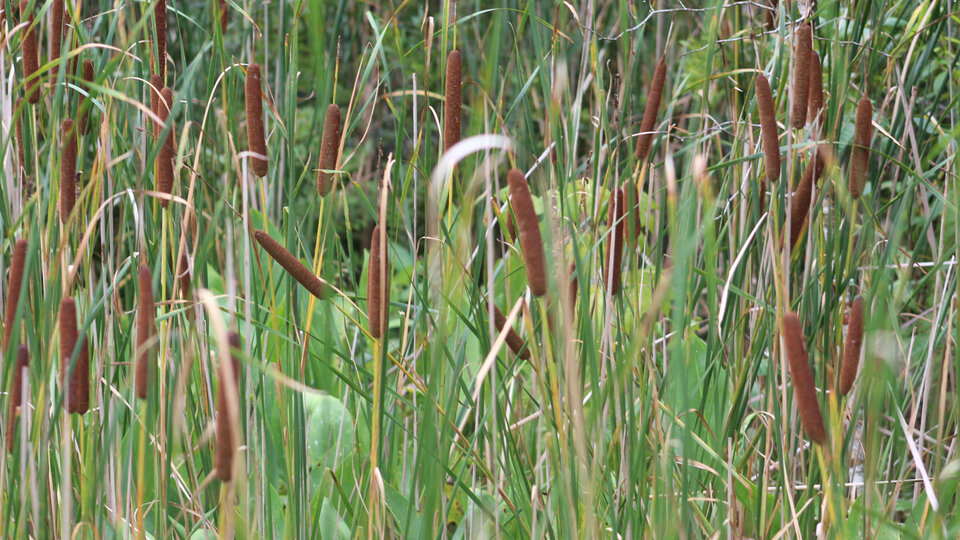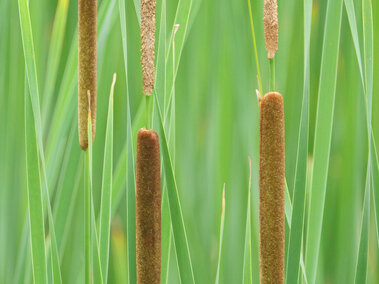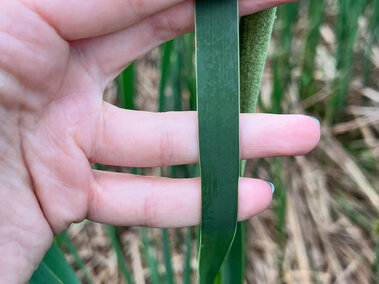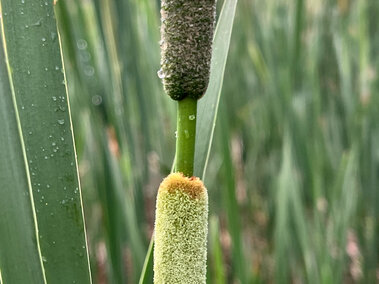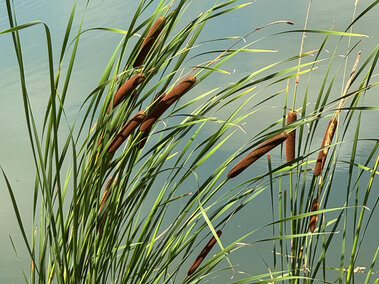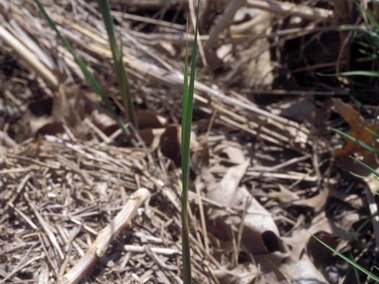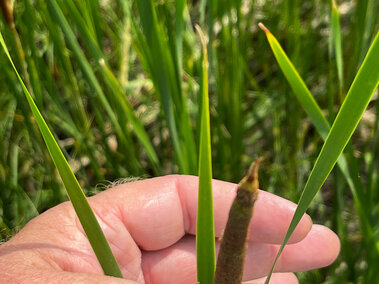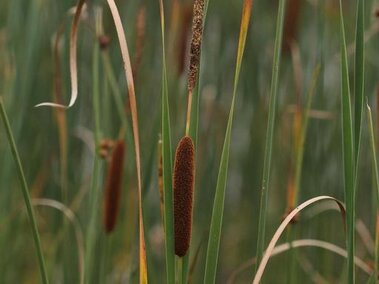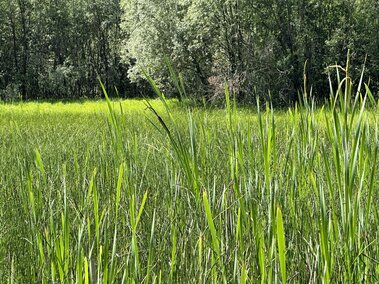General Information
Species Name: Typha angustifolia and hybrids (Typha glauca)
Also Known As: lesser bulrush, lesser reed-mace, nail rod, nail-rod, narrowleaf cattail, narrow-leaf cat-tail, narrow-leaved cattail, small reed-mace, southern reedmace
Family: Typhaceae (Cat-tail)
Growth Form: Forb (emergent aquatic)
Life Span: Perennial
Flowering Dates: Northern Africa, Asia, Eurasia
Origin: May-July
Noxious: No
Category 3: Established Aquatic Invasive Species
Why Is It Invasive?
Narrow-leaf cattail Invades freshwater marshes, wet meadows, fens, roadsides, ditches, shallow ponds, stream and lakeshores. While it plays an important role as a food source and shelter for some marsh-dwelling animals, large mono-specific stands of invasive cattails exclude some less common species. It is very aggressive, often out-competing native marsh species, decreasing their population sizes, to form dense monocultures. It also hybridizes with broad-leaved cattail (Typha latifolia) to form the probably even more competitive hybrid cattail (Typha glauca).
What Does It Look Like?
General Characteristics
Narrow-leaf cattail is a erect wetland plant that is 5-10 feet tall, often with a submersed base. Cattails are ubiquitous and easily recognizable by their thick, cylindrical spikes. Narrow-leaf cattail and its close relative, broad-leaved cattail (Typha latifolia), can be difficult to distinguish, and often hybridize into hybrid cattail (Typha glauca), further complicating identification.
Common (broad-leaved) cattail (Typha latifolia; native) generally does not have a gap between male and female sections of the inflorescence and differs in several often tiny features of the leaves, flowers, and fruits. Hybrid cattail (Typha x glauca) is a hybrid of common and narrow-leaved cattails, and its structure is intermediate between that of its parental species. The best way to identify the hybrids is to first learn the characteristics of T. angustifolia and T. latifolia, then look for plants that are intermediate.
Flowers
Numerous tiny flowers are densely packed into a cylindrical spike at end of the stem, divided into the upper section of yellow, male flowers and lower brown, sausage-shaped section of female flowers. The gap between male and female sections is about 0.5-4 inches (2-12 cm) in narrow-leaved cattail. They flower in late spring.
Leaves
Leaves are erect, linear, and flat, and the leaf blades are 0.15-0.5 inches wide, and up to three feet long. About 15 leaves emerge per shoot. Dark green in color and rounded on the back of the blade. The top of the leaf sheath has thin, ear-shaped lobes at the junction with the blade that usually disintegrates in the summer.
Stems
Stems are single, erect, stout, light green and unbranched. Vegetative colonies are often formed from spreading rhizomes.
Seeds
Seeds are tiny (about one mm), dispersed by the wind with the aid of numerous hairs. Each narrow-leaved cattail spike produces thousands of seeds that remain viable for up to 100 years.
Photos
Where Does It Grow?
Narrow-leaf cattail grows in marshes, ditches, fens, pond and lake margins, floating bog mats, roadside ditches, irrigation canals, oxbow lakes, and backwater areas of rivers and streams. It prefers full sun, wet conditions, and muddy soil. It can be found in wetlands at elevations lower than 2000 m. It also tolerates road salt and excessive silt and nutrients. Its ability to grow rapidly and tolerate environmental stressors enables it to dominate in inhospitable niches. In waters where T. latifolia and T. angustifolia are present, T. latifolia will often be in shallower waters closer to the shorelines, whereas T. angustifolia can survive in deeper water of 2-3 m.
How Does It Spread?
Narrow-leaf cattail is dispersed via canals, railroads, and highways. The origin of T. angustifolia is murky, some references claiming it is native to salt marshes on the east coast of North America and made its way west from there, others claiming is was introduced from Europe or Eurasia into Atlantic Coastal North America and migrated westward.
How Do I Control It?
Management of invasive aquatic plants involving either mechanical removal of plants or application of herbicides to public waters requires a permit. Contact the Contact the Nebraska Game and Parks Commission for more information.
Mechanical
Cut all stems, both green and dead in mid to late summer or early fall. Where possible, maintain a water level of a minimum of 3” above the cut stems for the entire growing season.
Cultural
CLEAN your watercraft, trailer, angling gear and other equipment. Remove all aquatic vegetation and animal species from your equipment.
DRAIN your watercraft at the ramp by removing the boat plug and draining all live wells and ballast tanks.
DRY your watercraft, trailer and other equipment for at least 7 days before visiting another waterbody. If coming from a known zebra mussel infested waterbody, allow your watercraft and equipment to dry for at least 30 days before using them on an un-infested waterbody.
DON'T LET IT LOOSE. Do not release or transport exotic or non-native fish species to new ecosystems, and do not dump aquariums. It is unlawful to release any aquatic species into a waterbody other than the one from which it was harvested. Doing so can promote the spread of AIS.
Chemical
Application of chemicals to public waters requires a permit. Contact the Contact the Nebraska Game and Parks Commission for more information.
What Should I Do If I See It in Nebraska?
If you see narrow-leaf cattail in Nebraska, you should report it to the Nebraska Game and Parks Commission's Aquatic Invasive Species (AIS) Program using their AIS Report Form. For guidance on what information to include in your report, check out our reporting tips.
References and More Information
California Native Plant Society
Center for Invasive Species and Ecosystem Health
Natural Resources Conservation Service
Nebraska Game and Parks Commission
North Carolina Extension Gardener Toolbox
